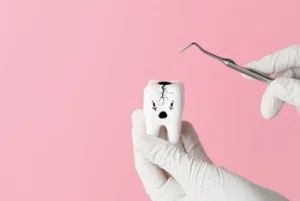Porcelain veneers are a recognised way to improve your smile with a natural-looking finish. One of the most common questions people ask before treatment is, “Do porcelain veneers stain?”
Understanding how this cosmetic dental treatment responds to common stain-causing foods and drinks can help you maintain its natural appearance for as long as possible.
Understanding Porcelain Veneers
Porcelain veneers are thin shells that get carefully bonded to the front surface of your natural teeth. They are designed to mimic the look and feel of natural enamel while offering a natural, uniform appearance.
How Veneers Work
During veneer placement, your dentist removes a thin layer of natural enamel to prepare the tooth surface. The veneers are then attached using dental cement, creating a durable bond that blends with both your teeth and gums.
Do Porcelain Veneers Stain?
Porcelain veneers are made from non-porous, high-quality materials that are more stain resistant than natural teeth. This means that they are less likely to absorb pigments from foods and drinks. However, stain-resistant does not mean stain-proof.
While porcelain veneers don’t stain easily, the bonding material and edges near the gum line may develop surface stains. These stains are often caused by lifestyle habits and exposure to staining agents over time.
Why Porcelain Veneers Are Less Likely to Stain
Porcelain veneers are often chosen for their ability to retain their colour and clarity over time.
While no material is completely immune to discolouration, porcelain offers distinct properties that make it less likely to stain compared to natural enamel or resin-based alternatives.
Non-Porous Surface
The structure of porcelain is non-porous, meaning it does not absorb pigments or stain-causing molecules as easily as tooth enamel.
This smooth, glass-like surface acts as a protective barrier, helping the veneers maintain their original shade even when exposed to everyday foods and drinks that can darken natural teeth.
High-Quality Materials and Natural-Looking Aesthetics
Porcelain dental veneers are crafted from high-quality ceramic materials designed to replicate the translucency and light-reflecting qualities of natural teeth.
These materials are not only durable but also engineered to resist long-term discolouration. Their composition helps them maintain a consistent tone, contributing to a balanced and natural-looking smile over time.
Comparison With Composite Veneers
While composite resin veneers can provide pleasing results, their resin material is more porous and therefore more susceptible to staining. Regular polishing can improve their appearance, but deep stains may still develop over time.
For this reason, composite veneers may need to be replaced sooner than porcelain veneers. Porcelain’s denser, smoother surface makes it a more stable option for those seeking long-lasting aesthetics with minimal maintenance.
Common Causes of Veneer Staining
While porcelain veneers are designed to be stain-resistant, certain factors can influence how well they maintain their colour and clarity over time.
Understanding these causes helps you take preventative steps to preserve their natural appearance and support your overall oral health.
Stain-Causing Foods and Drinks
Porcelain veneers themselves are less likely to absorb pigments, but the bonding material and surrounding enamel are more susceptible to surface stains.
Frequent exposure to certain foods and drinks may gradually affect the brightness of your smile. Common examples include:
- Coffee and tea
- Red wine
- Soy sauce and curry
- Dark berries
- Tomato-based sauces
These common stain-causing foods and beverages contain strong colourants that can attach to the microscopic texture of dental cement or the edges of veneers.
Over time, this can create a slight contrast between veneers and natural teeth. Limiting prolonged contact or rinsing with water after consumption can help reduce their impact.
Tobacco Use
Tobacco products contain tar and nicotine, which may be associated with surface discolouration. Even though porcelain dental veneers are resistant to staining, the bonding material and exposed enamel at the veneer margins can gradually darken with frequent use.
In addition, smoking may contribute to gum recession, making the edge of the veneer more visible and creating an uneven tone across the smile.
 Ageing and Gum Changes
Ageing and Gum Changes
As part of the natural ageing process, gums can begin to recede, revealing more of the tooth structure beneath the veneer.
This can lead to slight differences in colour or tone, particularly if the exposed enamel or bonding area becomes stained. Regular dental visits allow your dental practitioner to monitor these changes and recommend appropriate maintenance or adjustments when needed.
Stains on Natural Teeth vs Porcelain Veneers
Understanding the difference between how natural teeth and porcelain veneers respond to stains can help you make informed choices about care and maintenance.
Each material interacts with pigments differently, which can affect how your overall smile looks over time.
The Difference in Material
Natural teeth are protected by enamel, a strong yet porous outer layer that naturally absorbs pigments from food, drinks, and other substances. Over time, this can lead to gradual darkening or uneven colouration.
Porcelain veneers, in contrast, are crafted from a dense, glass-like ceramic material that is non-porous and highly resistant to external staining. This smooth surface prevents colourants from adhering, helping veneers maintain their shade for longer.
However, while the veneer itself is less reactive to pigments, the surrounding natural enamel and bonding material can still develop minor surface stains.
Maintaining a Consistent, Uniform Smile
Because veneers are typically applied to the front teeth, your natural back teeth remain uncovered and can still be affected by everyday staining. Maintaining a consistent colour across both your veneers and natural teeth helps ensure a balanced and harmonious smile.
Regular brushing with a non-abrasive fluoride toothpaste, paired with professional cleanings at your dentist’s office, supports this balance by removing surface stains and preserving the brightness of all visible teeth.
Periodic whitening of your natural teeth, if appropriate, can also help maintain a more uniform shade next to your veneers.
Can You Whiten Porcelain Veneers?
Teeth whitening treatments are effective on natural enamel but do not whiten veneers. Since veneers don’t absorb stains, whitening solutions can’t change their shade.
If you notice uneven colouring between your veneers and your natural teeth, a dentist may recommend whitening your natural teeth to match the veneers.
The Role of Proper Care
Caring for porcelain veneers is much like caring for your natural teeth. While the veneers themselves are resistant to stains and decay, the surrounding gum tissue and underlying tooth structure still require consistent care.
Establishing good daily habits and maintaining regular dental visits can help preserve both the function and appearance of your veneers.
Maintain Good Oral Hygiene
Good oral hygiene is the foundation of long-term dental health. Brush your teeth at least twice a day using a soft-bristled toothbrush and a non-abrasive fluoride toothpaste. This combination helps remove plaque without scratching the polished veneer surface.
Paying close attention to the gum line is particularly important, as this is where plaque and stains can begin to form over time.
Regular Flossing
Daily flossing helps protect the bonding area between your veneers and natural teeth. This simple yet essential step not only keeps your veneers clean but also supports the health of the gums and existing teeth beneath them.
For additional care, consider using interdental brushes or water flossers to gently clean between teeth without damaging the veneer edges.
Visit Your Dentist Regularly
Routine visits to your dentist’s office allow for professional cleanings, plaque removal, and monitoring of your veneers’ condition. Your dentist can identify early signs of wear, gum disease, or staining at the veneer margins and provide preventive care before problems develop.
Consistent professional care also helps maintain a harmonious balance between your veneers and natural teeth, ensuring your smile continues to look uniform and healthy.
When Veneers May Need to Be Replaced
Porcelain veneers are designed for long-term use, but like all dental restorations, they may eventually require replacement.
Understanding the signs that indicate it might be time for an assessment can help you maintain a healthy, balanced, and natural-looking smile.
Changes in Gum Line or Tooth Structure
As time passes, natural changes in your gums or the underlying tooth structure can affect how veneers fit and look. If the gums begin to recede, the edges of the veneers may become more visible, exposing the natural enamel underneath.
In some cases, minor adjustments may be enough. Still, if the veneers no longer align properly with your gum line, replacement may be recommended to maintain a consistent and natural appearance.
Broken Teeth or Chipped Veneers
Although porcelain veneers are made from durable, high-quality materials, they are not indestructible. Biting on hard or crunchy foods, clenching, or grinding can sometimes cause a veneer to chip or crack.
Similarly, trauma to the mouth can damage either the veneer or the tooth beneath it. Depending on the extent of the damage, your dentist may suggest repair, polishing, or complete replacement to restore the tooth’s aesthetics.
Worn or Stained Veneers

Regular dental check-ups help identify early changes in veneer condition, ensuring timely maintenance or replacement when needed.
With proper care and attention, well-made porcelain veneers can continue to complement your natural smile for many years.
Frequently Asked Questions
How long do veneers last?
Porcelain veneers can last for many years with proper care. Longevity depends on factors such as oral hygiene, dietary habits, and regular professional maintenance. Your dentist can assess when a veneer may need to be replaced.
How often should I visit my dentist after getting veneers?
It’s recommended to attend routine dental check-ups every six months, or as advised by your dentist. Regular visits allow for professional cleaning and early detection of any issues related to your veneers or oral health.
What’s the difference between veneers and crowns?
A veneer covers only the front surface of the tooth, while a dental crown encases the entire tooth. Veneers are usually recommended for aesthetic improvements, whereas crowns are used for more extensive restoration or protection.
Conclusion

By practising proper care, moderating your dietary habits, and scheduling routine professional cleanings, you can preserve your veneers and the health of both your teeth and gums for years to come.
If you’re exploring options to enhance your smile or would like to learn more about caring for veneers, our team is here to help. Contact Dr Jack Yang at (02) 9000 1778 or (02) 8806 3712 to book a consultation and discuss a suitable approach for your individual needs.
Note: Any surgical or invasive procedure carries risks. Before proceeding, you should seek a second opinion from an appropriately qualified health practitioner.
References
Dellwo, A. (2025, January 8). What You Need to Know Before Getting Dental Veneers. Verywell Health. Retrieved October 21, 2025, from https://www.verywellhealth.com/dental-veneers-8753531
Editorial Team. (2023, March 5). 5 Tips on Taking Care of Your Veneers. Meds News. Retrieved October 21, 2025, from https://www.medsnews.com/health/5-tips-on-taking-care-of-your-veneers/
Healthdirect Australia. (2025, February). Veneers. Healthdirect. Retrieved October 21, 2025, from https://www.healthdirect.gov.au/veneers
Owens, N. (2025, August 16). Tooth Discoloration. WebMD. Retrieved October 21, 2025, from https://www.webmd.com/oral-health/tooth-discoloration





 Ageing and Gum Changes
Ageing and Gum Changes



